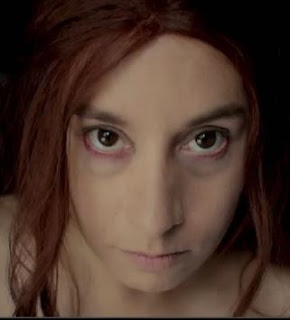Director
Jac Avila has created a definitive film version of the Marquis DeSade's
JUSTINE. The film, based on DeSade's famous novel about the misfortunes of
virtue, is in my opinion true to the book's spirit and content in a way no
other version has ever been.
If, hearing this is a film of DeSade's JUSTINE, you expect "sadistic" scenes of beautiful women subjected to whippings and other torturous ordeals, Avila's JUSTINE pulls no punches and will fulfill your expectations. But you can also approach this movie hungry for a refreshing tour de force of artistic filmmaking and have your desires fulfilled. Avila opens JUSTINE with a startling close-up of Justine's face, beautiful and innocent, but with a haunted look in her eyes that suggests she has already been through more horrors than we can imagine and knows the worst is probably yet to come. Amy Hesketh achieves this effect by looking straight at you in a certain way that has to be experienced to be understood. In the background we hear the ominous pounding of military drums, which immediately, given the situation, brought to my mind the "March to the Scaffold" in that great French symphony by Berlioz, SYMPHONIE FANTASTIQUE. And it was an appropriate association to make, for within moments, poor Justine is dragged away, bound in an X between two pillars, and mercilessly flogged, helplessly naked before a crowd of soldiers and elegantly dressed aristocrats. And, of course, this is only the beginning of what is to come. Hesketh again, as in other films, such as Avila's relentlessly realistic historical horror of Inquisitional terror, MALEFICARUM, pushes her art above and beyond to achieve another deeply sympathetic and totally convincing performance. Needless to say, there are no "mambo breaks" for her in JUSTINE, referring to the delightful Vampire Mambo sequence in OLALLA, the innovative and persuasively effective Vampire film she recently directed (available, as is JUSTINE, from Vermeerworks.com). JUSTINE's music, sets, casting, costuming, lighting, editing, and all the other intricate and vital aspects of quality filmmaking and behind the scenes production activities are all quite excellent to my mind, but because I am a writer, I especially appreciated the writing. The dialogue has a proper historic quality without being so authentic that modern ears might have trouble keeping up. This is a tricky effect to pull off, I guarantee, but JUSTINE does it with style. I especially enjoyed the narrative remarks spoken directly, from time to time, to the viewer by Justine, a technique that could have detached the audience from their involvement in the story if handled by a lesser filmmaker than Avila and spoken by a lesser actor than Hesketh. Bottom line, if you have read DeSade's novel then watched Avila's JUSTINE, you might be tempted to believe Avila either employed necromancy to resurrect the corpse of the Marquis long enough to write the screenplay, or that Avila took dictation from DeSade's ghost. I wish I had a time machine back to 1930s Paris and could screen Avila's JUSTINE for the founders of the Surrealist movement, the poets, philosophers, filmmakers, and artists. Many fans of DeSade's writing and challenging philosophy do not realize how important he was to the Surrealists. DeSade was plumbing the forbidden depths of the subconscious long before Freud, and the subconscious is where many dreams are spawned. Dream imagery as a key to unearthing hidden psychological urges was an important theme of surrealist expression. To the surrealists, DeSade was an explorer of forbidden themes and a foe of religious and societal hypocrisy. Consider this in connection with Avila's JUSTINE. According to SURREALISM: PERMANENT REVELATION by Cardinal and Short, the surrealists valued DeSade "…for his lucid exploration of man's darkest instincts." Avila's film also explores those instincts, in spades. From THE HISTORY OF SURREALIST PAINTING by Marcel Jean, we are told that Luis Buñuel's film, L'AGE D'OR (AGE OF GOLD), includes the Comte de Blangis, Sade's protagonist in 120 DAYS OF SODOME, appearing as Jesus Christ, and the last image in the film is of a crucifix to which several women's scalps are nailed. Avila's last scene of surreal sadism in his JUSTINE, however, takes Buñuel's climactic image to another level entirely. As for the surreal life-death, eros-thanatos juxtapositions in DeSade's novel and Avila's film, DEATH AND SENSUALITY: A STUDY OF EROTICISM AND THE TABOO by Georges Bataille says, in a chapter on DeSade, "Life, he maintained, was the pursuit of pleasure, and the degree of pleasure was in direct ratio to the destruction of life. In other words, life reached its highest intensity in a monstrous denial of its own principle." And with Avila's JUSTINE, this surreal theme is definitively expressed. So, yes, I enthusiastically recommend Jac Avila's JUSTINE. I believe that the Divine Marquis would approve of its challenging, morality- twisting philosophy and scenes of well-whipped flesh. I think that Luis Buñuel and Salvador Dali would applaud its surreal juxtapositions of potent imagery. And I feel that filmmakers can study and learn from Avila's masterful new film for years to come. But most importantly, ordinary blokes like me can just be entertained, gawk in wonder, and cheer. The right person has finally created a film version of JUSTINE that brings DeSade's book to uncompromising, throbbing life.
For
full cast and crew and other detailed information on IMDB, use this link:
|
Saturday, October 29, 2016
Jac Avila's JUSTINE Review
Subscribe to:
Post Comments (Atom)

No comments:
Post a Comment